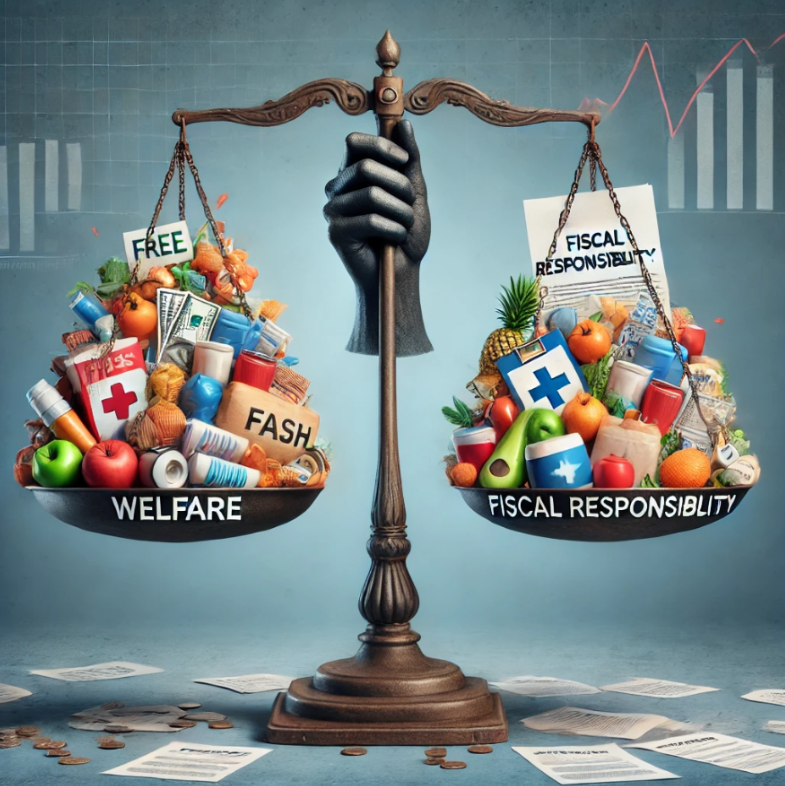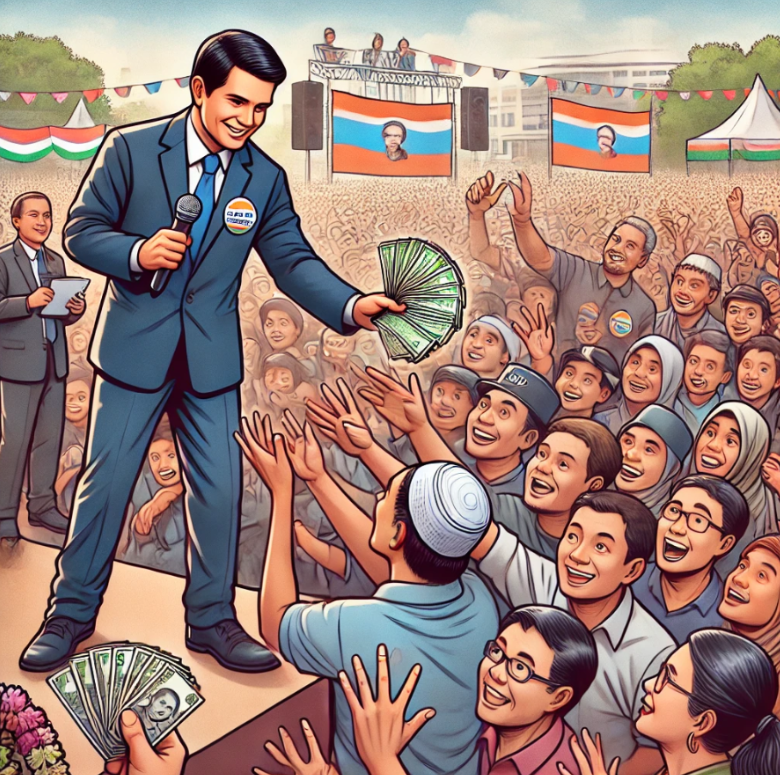The Economic Impact of Freebies
- Mohammed Mubeen Mazar Khan

- Mar 10
- 5 min read
Updated: May 20
Every day, we benefit from various government-provided facilities—whether it's taking a subsidized bus ride to the city, free education, or receiving costless electricity up to a certain limit. But have you ever wondered where the funds for these "freebies" come from and what impact they have on the government, the people, and, most importantly, the economy?
In this article, we will explore the topics of freebies and how they can both help and hurt the economy. Freebies is a term that has been thrown around quite loosely, of late. So, let's first look at what freebies actually are and how different state governments have been providing them.
What are Freebies?
Freebies are fundamental items offered by governmental authorities as well as some non-governmental organizations (NGOs). These freebies are typically intended to support a specific type of agenda.
Freebies are in general, more beneficial to lower-income groups who cannot afford basic goods such as groceries and transportation. For example, Delhi, Tamil Nadu, and Andhra Pradesh all provide free bus services to all women, while AP and Karnataka provide free bus services to students as well. In Tamil Nadu, highly subsidised food groceries are provided to the low income groups (Amma Unavagam), and mid-day meals are also accommodated for students.

How do Freebies Help?
As mentioned earlier, freebies are often introduced to promote specific policy agendas that contribute to a nation’s overall development. Their impact can be seen across various sectors:
1. Social Welfare and Equity
Economic Redistribution: By providing essentials such as food, education, and healthcare at no cost or subsidized rates, governments ensure a basic standard of living for economically weaker sections.
Gender Equity: Initiatives such as free education, transportation, and financial aid for women and girls foster gender equality and empowerment.
Rural Development: Free utilities, including electricity, water, and LPG connections, enhance the quality of life in rural areas.
2. Poverty Alleviation
Food Security: Free ration programs help combat hunger and malnutrition, especially in underserved regions.
Basic Needs Provision: Subsidized housing, energy, and water reduce financial burdens on low-income households.
Skill Development: Free equipment, vocational training, and educational materials (such as laptops and bicycles) enhance employability and economic mobility.
3. Women’s Empowerment
Access to Employment: Free transportation schemes enable women to seek jobs in areas that were previously inaccessible.
Education Support: Financial aid for women's education helps break socio-economic barriers, discourages outdated practices, and fosters empowerment.
4. Public Health and Nutrition
Combating Malnutrition: Midday meal programs and subsidized food grains help address hunger and nutritional deficiencies.
Universal Healthcare: Free medical services and essential medicines improve health outcomes, particularly for low-income groups.
Sanitation & Hygiene: Providing free toilets and hygiene kits encourages better sanitation practices, reducing the spread of diseases.
These initiatives demonstrate how freebies, when implemented effectively, can serve as powerful tools for social and economic progress. However, their long-term sustainability remains a crucial aspect of discussion.
The Rationale Behind Freebies
Managing fiscal policy in the face of growing government spending, particularly the provision of freebies, necessitates a careful balance between avoiding excessive debt collection and ensuring economic stability. Here are the basic procedures that governments take to manage their fiscal policy, as well as the effects on inflation, deficits, and the economy.
1. The Rationalization of Expense
The government makes sure to spend in the areas that are most needed, which eliminates unnecessary expenditure and enhances efficiency.
Public-private partnership (PPP) - the government works with private companies to create new infrastructure, which helps lower costs.
2. Debt Management
State governments often seek loans from domestic or international sources while ensuring they do not face currency-related risks. This enables them to fund development projects without disrupting essential services.
3. Promoting Economic Development and Growth
Freebies enable the government to stimulate economic growth among the people, resulting in larger returns on tax collection, which are then poured back into economic development, establishing a cycle of growth.
Now lets discuss short term and long term effects of freebies on the economy.

Short Term Effects of Freebies
1. Inflation
Providing freebies increases people's purchasing power, leading to a surge in demand for essential goods and services. If supply fails to keep pace, this heightened demand can drive up prices, resulting in inflation.
Example: Suppose farmers sell their goods to the government in bulk at a price which both parties are satisfied with. The government then distributes these goods for free to the poor. Now, the farmers have fewer goods to sell in the market, which are to be consumed by the middle and upper classes. Due to lack of supply, this will cause the prices of grains and consumables to rise greatly thus causing inflation.
Additionally, factors like limited production capacity, transportation issues, or import dependencies can increase the supply shortages, intensifying inflation.
2. Monetary Policy Interaction
To combat inflation caused by excessive demand, central banks (such as the Reserve Bank of India) may intervene by increasing interest rates. Higher interest rates make borrowing more expensive, reducing consumption and investment, thereby slowing demand
Example: If loans for buying vehicles or homes become costlier, fewer people borrow, reducing demand. This reduced demand helps ease inflationary pressures in those sectors.
3. Fiscal Deficit
While freebies are funded through government revenue—primarily taxes and other income sources—overspending beyond budgeted limits can lead to a fiscal deficit. This occurs when the government's expenditures exceed its earnings, forcing it to borrow funds either domestically or internationally.
A growing fiscal deficit can have several consequences:
Reduced ability to invest in critical infrastructure like roads, hospitals, and public housing.
Increased public debt, as governments take loans to cover budget shortfalls, potentially leading to long-term financial instability.
These short-term challenges highlight the delicate balance required in implementing freebies without compromising economic stability.
Long Term Effects of Freebies
1. Affordibility of Debt
Continuous overspending, particularly on non-productive giveaways, can lead to unsustainable debt levels. Rising debt servicing costs divert funds from essential development projects, slowing long-term economic growth. Essentially, more and more money goes into paying back interest, rather than into productive channels.
2. Stagnant Economic Growth
While freebies aim to stimulate economic growth, they may not always generate the expected returns. A poorly structured freebie system can create dependency, reducing incentives for productivity and self-sufficiency. This can lead to stagnation rather than progress.
3. Decline in Private Investment
Due to increased amounts of debt with higher interest rates, it becomes almost impossible for the government to invest in the private sector , this hinders its development, causing low rate of job creation and innovation.
These long-term effects highlight the importance of carefully designing welfare policies to balance social support with economic sustainability.
Conclusion
Freebies, such as free bus transportation for women in Telangana and Karnataka, have both advantages and challenges in shaping economic growth. On the positive side, they enhance access to education, employment, and healthcare, fostering empowerment and boosting local demand, which can contribute to short-term economic expansion. However, these benefits come at a cost. If revenue generation fails to match increased government spending, fiscal deficits may widen, putting strain on public finances. Additionally, an unchecked rise in demand can contribute to inflation, making essential goods and services more expensive.
While well-targeted welfare measures can drive social and economic progress, excessive dependence on freebies risks creating long-term financial instability, increasing public debt, and burdening future generations. A balanced approach—where social welfare initiatives are complemented by sustainable economic policies—is crucial to ensuring both immediate benefits and long-term fiscal responsibility.
-Mohammed Mubeen Mazar Khan



Comments